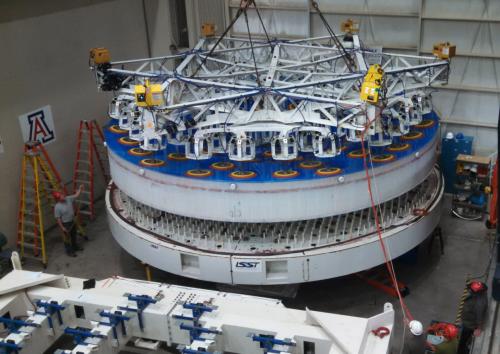In February, LSST achieved a significant milestone with the primary/tertiary mirror (M1M3) – completion of the mirror surfaces’ polishing effort and successfully placing the $20 million mirror substrate in its storage container, where the LSST team will conduct additional integrated testing before final shipment to Chile in the coming years.
On February 13, the LSST Project accepted the M1M3 mirror surfaces without conditions, given their outstanding characteristics and overall expected performance. Acceptance, which marked completion of the polishing effort, followed rigorous testing and analysis jointly performed by Steward Observatory Mirror Lab (SOML) and LSST Project staff.
Interferometric measurements confirmed the finished surfaces of both M1 and M3 met or exceeded their surface function requirements for surface uniformity and figure accuracy over their full clear apertures. The positioning of the M3 surface with respect to the M1 surface has also been measured to be within tolerance for this unique dual surface monolithic mirror. All other specifications of the combined two mirror surfaces are within their tolerances including radii of curvature, conic constants, and other physical characteristics.
In a carefully executed multi-day procedure in late February, the M1M3 mirror was successfully placed in its storage container at SOML. The LSST team led by Jacques Sebag and the SOML team led by Kurt Kenagy deserve congratulations for flawlessly achieving this critical and complex maneuver.
The first day of the mirror lift began early, with a thorough review of the procedure including all safety concerns. A lifter composed of 54 vacuum pads was used to transfer the mirror from its polishing cell into its transport container. This lifter, supported by a crane, was positioned above the mirror and lowered very slowly to enable contact of the pads with the mirror. At this point, with the pads no longer in contact with the lifter, the mirror only supported the weight of the pads not the weight of the lifter. After final positioning of the pads, six pumps connected to them were used to create a vacuum under each pad (the pumps are the yellow boxes located on the lifter in the image). After achieving the required vacuum, the pumps were then turned off and the pressure monitored carefully overnight to ensure the leak rate was minimal. This safety step was one part of the many procedures within the lifting process to ensure a safe lift with reliable equipment.
The second day of the mirror lift also began early and again with a thorough safety review. The overnight pressure was verified in each of the lines for all the vacuum pads and the pumps turned back on. Using the crane, the lifter was first raised little by little to re-establish contact with the vacuum pads. At this point, the M1M3 mirror was suspended on the crane. It was lifted very slowly from the polishing cell to clear the thermal injectors, smoothly translated laterally, and positioned above the storage container located next to the polishing cell. The last step was to clock and lower the load to enable bolts to capture the mirror onto the pivot arm supports, which are located in the transport box in the same orientation as the mirror. The overall procedure lasted for most of the day and proceeded smoothly. An inspection of the back of the mirror the following day revealed no problems with the glass and this important milestone was declared a great success.
The vibrant shade of blue on the M1M3 surface is a thin polyethylene coating previously applied to protect the mirror during the lift procedure and while in storage.
Formal delivery of M1M3 is expected in early April, when the LSST Project will take responsibility for the mirror in its shipping container and move it to a secure storage facility in Tucson.
More images of the mirror lift
Local news coverage of the mirror lift


